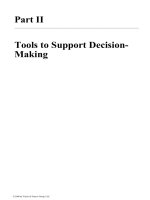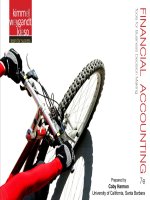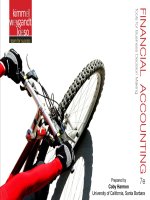Financial accounting 8e tool for busniess decision making chapter 02
Bạn đang xem bản rút gọn của tài liệu. Xem và tải ngay bản đầy đủ của tài liệu tại đây (2.23 MB, 65 trang )
2-1
2
A Further Look at Financial
Statements
Kimmel ● Weygandt ● Kieso
Financial Accounting, Eighth Edition
2-2
CHAPTER OUTLINE
LEARNING OBJECTIVES
2-3
1
Identify the sections of a classified balance sheet.
2
Use ratios to evaluate a company’s profitability, liquidity, and solvency.
3
Discuss financial reporting concepts.
LEARNING OBJECTIVE
1
Identify the sections of a classified balance sheet.
Presents a snapshot at a point in time.
To improve understanding, companies group similar assets and similar liabilities together.
Standard Classifications
Assets
Liabilities and Stockholders’ Equity
Current assets
Current liabilities
Long-term investments
Long-term liabilities
Property, plant, and equipment
Stockholders’ equity
Intangible assets
ILLUSTRATION 2-1
Standard balance sheet classifications
2-4
LO 1
ILLUSTRATION 2-2
Classified balance sheet
2-5
LO 1
ILLUSTRATION 2-2
Classified balance sheet
2-6
LO 1
THE CLASSIFIED BALANCE SHEET
Current Assets
Assets that a company expects to convert to cash or use up within one year or the
operating cycle, whichever is longer.
Operating cycle is the average time it takes from the purchase of inventory, to the sale of
goods, and then to the collection of cash from customers.
Common types of current assets are (1) cash, (2) investments, (3) receivables, (4)
inventories, and (5) prepaid expenses.
2-7
LO 1
THE CLASSIFIED BALANCE SHEET
Current Assets
Illustration 2-3
Current assets section
Companies list current asset accounts in the order they expect to convert them into cash.
2-8
LO 1
THE CLASSIFIED BALANCE SHEET
Review Question
Cash, and other resources that are reasonably expected to be realized in cash or sold or consumed in
the business within one year or the operating cycle, are called:
2-9
a.
Current assets.
b.
Intangible assets.
c.
Long-term investments.
d.
Property, plant, and equipment.
LO 1
THE CLASSIFIED BALANCE SHEET
Long-Term Investments
Investments in stocks and bonds of other corporations that are held for more than one year.
Long-term assets such as land or buildings that a company is not currently using in its
operating activities.
Long-term notes receivable.
ILLUSTRATION 2-4
Long-term investments section
2-10
LO 1
THE CLASSIFIED BALANCE SHEET
Property, Plant, and Equipment
Long useful lives.
Alternative Terminology
Property, plant, and equipment is sometimes called fixed
assets or plant assets.
2-11
Currently used in operations.
Includes land, buildings, equipment, delivery vehicles, and furniture.
Depreciation - allocating the cost of assets to a number of years.
Accumulated depreciation - total amount of depreciation expensed thus far in the asset’s life.
LO 1
Property, Plant, and Equipment
ILLUSTRATION 2-5
Property, plant, and equipment section
2-12
LO 1
THE CLASSIFIED BALANCE SHEET
Intangible Assets
▼Helpful Hint Sometimes
intangible assets are reported
Assets that do not have physical substance.
Includes goodwill, patents, copyrights, and trademarks or trade
under a broader heading called
“Other assets.”
names.
2-13
LO 1
THE CLASSIFIED BALANCE SHEET
Intangible Assets
ILLUSTRATION 2-6
Intangible assets section
Illustration 2-6
2-14
LO 1
THE CLASSIFIED BALANCE SHEET
Review Question
Patents and copyrights are
2-15
a.
Current assets.
b.
Intangible assets.
c.
Long-term investments.
d.
Property, plant, and equipment.
LO 1
DO IT!
1a
Assets Section of Classified Balance Sheet
Baxter Hoffman recently received the following information related to Hoffman Corporation’s December 31,
2017, balance sheet.
Prepaid insurance
$ 2,300
Cash
800
Equipment
Accounts receivable
Inventory
10,700
$3,400
Accumulated depreciation—
equipment
2,700
1,100
Prepare the assets section of Hoffman Corporation’s classified balance sheet.
2-16
LO 1
Prepare the assets section of the classified balance sheet.
Prepaid insurance
$ 2,300
Cash
800
Equipment
Accounts receivable
2-17
Inventory
10,700
1,100
$3,400
Accumulated depreciation—
equipment
2,700
THE CLASSIFIED BALANCE SHEET
Current Liabilities
Obligations the company is to pay within the next year or operating cycle, whichever is
longer.
Common examples are accounts payable, salaries and wages payable, notes payable, interest
payable, and income taxes payable.
Also included as current liabilities are current maturities of long-term obligations—
payments to be made within the next year on long-term obligations.
2-18
LO 1
THE CLASSIFIED BALANCE SHEET
Current Liabilities
ILLUSTRATION 2-7
Current liabilities section
2-19
LO 1
THE CLASSIFIED BALANCE SHEET
Long-Term Liabilities
Obligations a company expects to pay after one year.
Include bonds payable, mortgages payable, long-term notes payable, lease liabilities, and
pension liabilities.
ILLUSTRATION 2-8
2-20
Long-term liabilities section
LO 1
THE CLASSIFIED BALANCE SHEET
Review Question
Which of the following is not a long-term liability?
2-21
a.
Bonds payable.
b.
Current maturities of long-term debt.
c.
Long-term notes payable.
d.
Mortgages payable.
LO 1
THE CLASSIFIED BALANCE SHEET
Stockholders’ Equity
Common stock - investments of assets into the business by the stockholders.
Retained earnings - income retained for use in the business
Stockholders’ Equity section for Franklin Corporation
Illustration 2-2
2-22
LO 1
1b
DO IT!
Balance Sheet Classifications
Match each of the items to its proper balance sheet classification, shown below. If the item would not appear on a balance sheet, use “NA.”
Current assets (CA)
Current liabilities (CL)
Long-term investments (LTI) Long-term liabilities (LTL)
Property, plant, and equipment (PPE)
Stockholders’ equity (SE)
Intangible assets (IA)
Solution
2-23
CL
Salaries and wages payable
LTI
Investment in real estate
NA
Service revenue
PPE
Equipment
CL
Interest payable
PPE
Accumulated depreciation
IA
Goodwill
CA
Debt investments (short-term)
NA
Depreciation expense
SE
Retained earnings
LTL
Mortgage payable
CL
Unearned service revenue
(due in 3 years)
LO 1
LEARNING OBJECTIVE
2
Use ratios to evaluate a company’s profitability, liquidity, and
solvency.
Ratio Analysis
2-24
Ratio analysis expresses the relationship among selected items of financial statement data.
A ratio expresses the mathematical relationship between one quantity and another.
A single ratio by itself is not very meaningful.
LO 2
RATIO ANALYSIS
ILLUSTRATION 2-9
Financial ratio classifications
2-25
LO 2









